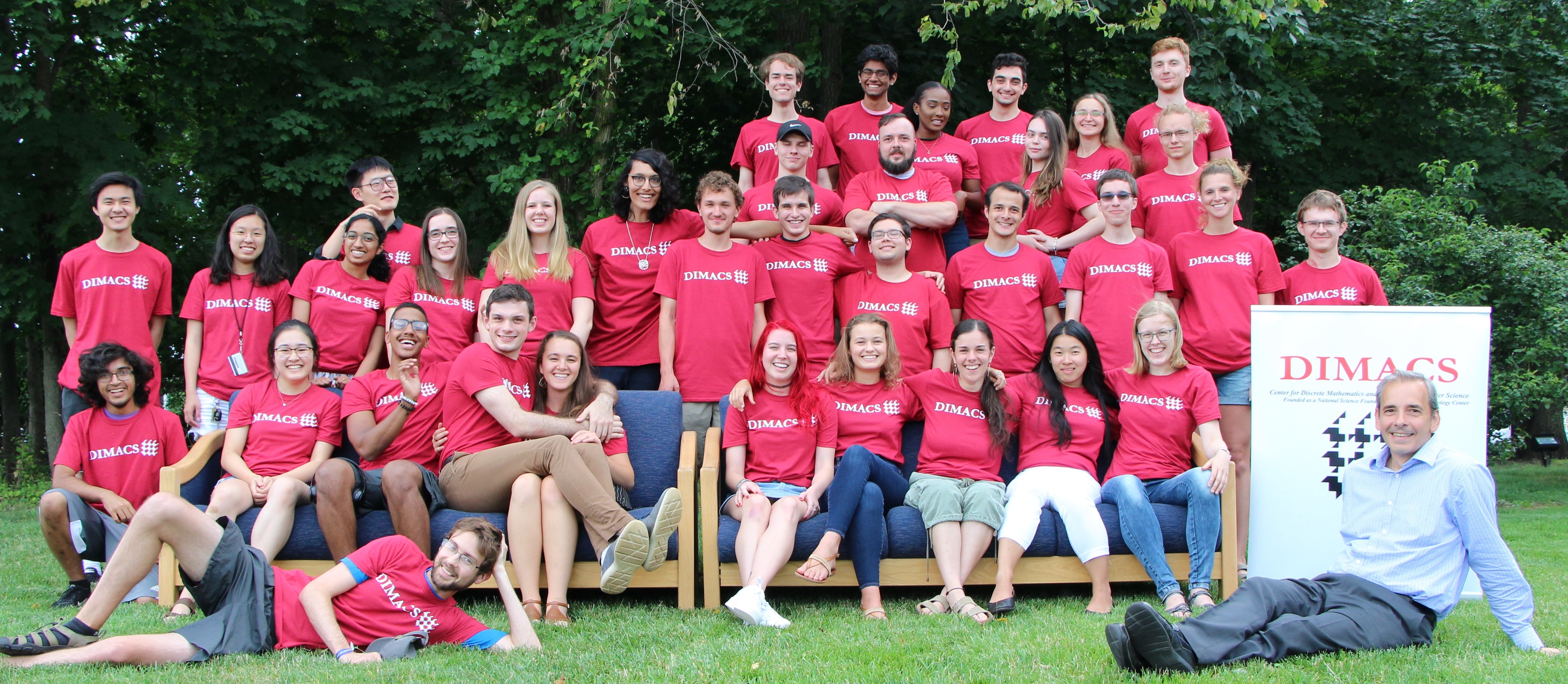CoSP Research Experiences for Undergraduates 2019
May 28 - July 21, 2019, Rutgers, Piscataway, NJ, USA
July 21 - August 2, 2019, Charles University, Prague, Czech Republic

List of participants from Charles University
- Pavel Dvořák (graduate coordinator)
- Jakub Pekárek (2nd graduate coordinator)
- Mikhail Beliyeu
- Andrej Dedík
- Petr Chmel
- Lukáš Ondráček
- Petra Pelikánová
- Jan Petr
- Jan Soukup
- Aneta Šťastná
List of participants from the US
- Parker Hund (Graduate coordinator)
- Austin Allen
- Azucena Garvia
- Kyle Hess
- Amulya Musipatla
- Shoshana Simons
Research projects of the Czech group
Random walks with excited vertices
Mentor: Bhargav Narayanan
Students: Petr Chmel, Jan Petr, Mikhail Beliyeu
When considering simple random walks on a graph, it is known that the expected hitting time has the upper bound of approximately O(n^3). However, the random walker may use some heuristics or biases to try to get to the target vertex quicker.
One of such biases is 'geodesic bias' - some vertices in the graph are 'excited' and from them, the random walker takes a step along a fixed shortest path. The question is, do the upper bounds differ?
Space-Time-Depth
Mentor: Periklis Papakonstantinou
Students: Pavel Dvořák, Kyle Hess, Lukáš Ondráček, Jakub Pekárek
Let M be a Turing machine working in time T(n). Trivial upper bound for used space by M is T(n). There is constructions of Turing machine M' such that M' is equivalent to M and it uses only T(n)/log T(n) space. There is also a construction of circuit C equivalent to M such that the depth of the circuit is T(n). Can we do better?
Rainbow cycles
Mentor: Sophie Spirkl
Students: Petra Pelikánová, Aneta Šťastná
The main goal of this project is to obtain some partial result of the following conjecture by Aharoni: Let G be an n-vertex graph and let {E_1,...,E_n} be a partition of its edge set with |E_i| <= k for all i in [n] and for some natural number k. Then, G has a rainbow cycle of length at most ceiling of n/k.
This conjecture generalizes conjecture of Caccetta-Häggkvist: Let G be an n-vertex directed graph such that every vertex has out-degree at least k. Then, G has a directed cycle of length at most ceiling of n/k.
Ramsey-like game
Mentor: Sophie Spirkl
Students: Andrej Dedík, Jan Soukup
Consider the following game. It is played by two players on an intially empty discrete graph. One player tries to force induced subgraph (which is given at the start of the game) by choosing stable sets, into which the other player has to draw edges. The forcing (player one) player wins if he forces second player to complete the induced subgraph. Other player wins if forcing player fails to do so. The question which pops up is: Is it always possible to force graph on some given number of vertices? This question has been answered, and as it turns out, the answer is yes - for each graph there is such a number of vertices, such that forcing player has strategy to force the graph in question. What we do not know though, is what this number is for most of the known graphs. We know, that for complete graphs the number is (for obvious reasons) Ramsey's number, but not much else is known. There is an lower and upper bound, but they are really quite far from each other. Hence our goal is to get a deeper understanding of this problem and investigate if these bounds could be squeezed together more tightly.
Prague part of REU
Conference during the Charles University program:REU volume (Brochure)
The report from REU 2019 is published as no. 2080-680 in ITI-series 2020.Funding
 This project has received funding from the European Union's Horizon 2020 research and innovation programme under the Marie Skłodowska-Curie grant agreement No 823748.
This project has received funding from the European Union's Horizon 2020 research and innovation programme under the Marie Skłodowska-Curie grant agreement No 823748.
 Project acronym: CoSP
Project acronym: CoSP
Project title: Combinatorial Structures and Processes
Grant agreement no.: 823748
Website: kam.mff.cuni.cz/rise
Senior organizer: Martin Loebl
Graduate coordinators: Pavel Koblich Dvořák, Jakub Pekárek
Past REUs
- REU 2019 - May 28 - August 2, 2019
- REU 2018 - May 28 - August 3, 2018
- REU 2017 - May 30 - August 1, 2017
- REU 2016 - May 30 - July 30, 2016
- REU 2015 - May 31 - August 1, 2015
- REU 2014 - June 1 - August 1, 2014
- REU 2013 - June 2 - August 7, 2013
- REU 2012 - June 3 - August 8, 2012
- REU 2011 - May 31 - August 3, 2011
- REU 2010 - June 2 - August 4, 2010
- REU 2009 - June 1 - August 5, 2009
- REU 2008 - June 2 - August 6, 2008
- REU 2007 - June 4 - August 8, 2007
- REU 2006 - June 5 - August 9, 2006
- REU 2005 - June 6 - August 10, 2005
- REU 2004 - June 7 - August 11, 2004
- REU 2003 - June 9 - August 13, 2003
- REU 2002 - June 10 - August 14, 2002
- REU 2001 - June 11 - August 17, 2001
- REU 2000 - June - August, 2000
- REU 1999 - June 6 - August 1, 1999
Webmaster: kamweb@kam.mff.cuni.cz Modified: 11. 05. 2021
